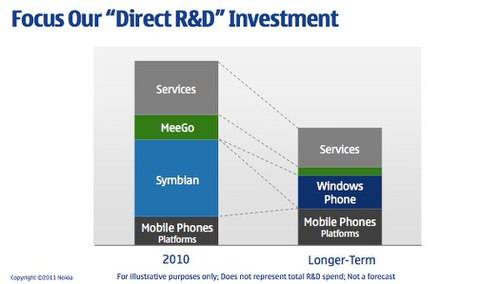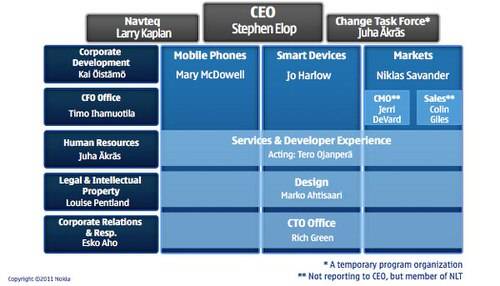As expected, Nokia and Microsoft announced a new partnership deal ahead of Nokia’s Capital Markets Day which will align the two companies to compete together in the mobile economy. As part of the strategy, Nokia will begin using Microsoft’s new Windows Phone 7 operating system on its mobile devices as its primary smartphone platform, and Nokia’s current mobile platform Symbian will eventually be phased out. Nokia’s original plan to use its MeeGo operating system on high-end smartphones also takes a backseat under the new deal – MeeGo will become an open-source “project” with just one device launching this year. Both companies will collaborate on development, marketing and their mobile roadmap, they said.

Meanwhile, Microsoft’s Bing search engine and related services and its adCenter search advertising services will come Nokia devices.
Nokia Putting Out Fire on its “Burning Platform”
New Nokia CEO Stephen Elop, a former Microsoft exec who took the helm last fall, has moved quickly to bring change to the Finnish company whose market share has been steadily dropping in the face of increased competition from Google and Apple. He recently sent a memo to employees, rallying the company to change. “I believe we have lacked accountability and leadership to align and direct the company through these disruptive times,” he wrote. “We had a series of misses. We haven’t been delivering innovation fast enough. We’re not collaborating internally. Nokia, our platform is burning.”
With a deal of this magnitude, casual observers may have several questions. What does this mean for Symbian? What of Qt, Nokia’s development platform? What’s to become of MeeGo? Who’s in charge of what at Nokia?
We’ll attempt to answer those questions below.
1. What Will Happen to Symbian? (And When?)
With Nokia’s new mobile strategy, Windows Phone 7 will displace Symbian…eventually. In a slide presented by Elop and Nokia CFO Timo Ihamuotila, it’s clear that Symbian will be wholly replaced by Windows Phone 7. However, the slide was not meant to be a forecast as to when that transition will complete. That said, Symbian will certainly begin to spiral downwards in terms of developer interest almost immediately – few parties will want to build apps for a dying platform with no future.

Nokia says Symbian will become a “franchise platform, leveraging previous investments to harvest additional value,” but tried to downplay its death by touting sheer numbers:
“This strategy recognizes the opportunity to retain and transition the installed base of 200 million Symbian owners. Nokia expects to sell approximately 150 million more Symbian devices in the years to come.”
2. What’s Going on with MeeGo?
MeeGo, a joint OS project built from Nokia’s Maemo platform and Intel’s Mobiln OS was, at one time, going to be Nokia’s means of competing in the smartphone market. Now, it will become an “open-source, mobile operating system project,” says Nokia. “MeeGo will place increased emphasis on longer-term market exploration of next-generation devices, platforms and user experiences. Nokia still plans to ship a MeeGo-related product later this year.”
What does that mean, exactly?
It means that Elop didn’t think that Nokia could build a smartphone ecosystem around MeeGo quickly enough to compete on the new, and rapidly changing smartphone market. Now, says Elop, MeeGo will serve, “not as part of another broad smarpthone platform strategy, but as an opportunity to learn.”
Only one MeeGo-based device will ship this year, probably because it’s so late into the process, Nokia sees no reason not to. However, after that phone ships, the MeeGo team will change focus to work on “exploration of future platforms, future devices and future user experiences.”
Intel, which was a partner in Nokia’s earlier plans for MeeGo, has this to say: “While we are disappointed with Nokia’s decision, Intel is not blinking on MeeGo. We remain committed and welcome Nokia’s continued contribution to MeeGo open source.”

3. What’s to Become of Qt?
Nokia’s work at making its development environment Qt easier to use – efforts which were seeing moderate success, Nokia said in November – will no longer matter in the company’s new strategy. That’s because going forward, developers will use Microsoft’s tools for Windows Phone. Specifically, they will have access to Visual Studio 2010, Expression, Silverlight and the XNA Framework. Qt will be phased out, like Symbian.

In a letter to developers, Nokia spelled out details of the changes, again downplaying the change by touting how Nokia still plans to sell “around 150 million more Symbian devices.” The company also noted that the MeeGo project will use Qt.
In addition, Nokia boasted of Ovi Store numbers in the letter: 190 countries, with local specific content in 90 of those, 4 million downloads a day, 300,000 users signing up daily and 400,000 developers.
As a part of the company’s organizational changes, its Services and Developer Experiences (SDX) unit will be responsible for Nokia’s global service portfolio, developer offering, developer community relations, and integration of partner service offering, the company said. That also includes Forum Nokia, which will continue to support developers for Symbian smartphones and Series 40 mobile phones.
4. What’s Happening on the Organizational Level?
Both Nokia itself and its management structure has be reorganized based on the new strategy. However, the rumors had gotten this part wrong – Elop isn’t dismissing its top execs, just moving them around.
As of April 1, Nokia will have a new company structure, which features two distinct business units: Smart Devices and Mobile Phones.
- Smart Devices will be responsible for creating the Windows Phone portfolio and will also house the sub-units of Symbian smartphones, MeeGo Computers and Strategic Business Operations. Jo Harlow will lead this group.
- Mobile Phones will “leverage its innovation and strength in growth markets to connect the next billion people and bring them affordable access to the Internet and applications,” said Nokia. Mary McDowell will lead Mobile Phones.
- Niklas Savendar will run Markets, which is responsible for “selling products, executing compelling marketing and communications, creating a competitive local ecosystem, sourcing, customer care, manufacturing, IT and logistics across all Nokia products.”
- Tero Ojanpera will lead the Services and Developer Experience unit which is responsible for Nokia’s global services portfolio, developer offering, developer relations and integration of partner service offerings.
- Design, responsible for Nokia product and user experience design, will be led by Marko Ahtisaari.
- Rich Green will be CTO.
- Timo Ihamuotila is CFO.
- Corporate Development, responsible for driving implementation of Nokia’s ecosystem strategy and strategic partnerships, will be headed by Kai Oistamo.
- Corporate Relations & Responsibility, responsible for Nokia’s government and public affairs, sustainable development and social responsibility, will be led by Esko Aho.
- Human Resources will be led by Juha Akras.
- Alberto Torres, the EVP of MeeGo, has stepped down from the management team, effective February 10 to “pursue other interests.”

Additionally, Nokia will be cutting thousands of jobs in Finland and elsewhere in the world. Nokia and Nokia Siemens Networks employed some 132,000 people at the end of last year, and of those 19,800 were in Finland.
5. Does this Mean Nokia/Microsoft Will Have a New Tablet Strategy?
Although nothing specific to tablets was laid out by either company, Elop did confirm that Nokia had tablet plans in the works.
“When it comes to this platform, we reserve the right to introduce tablets on other platforms, he said. “Whether that be internal projects or we could take advantage of what Microsoft is innovating with, we’ve nothing to announce on that today.”
However, the tablet will not run MeeGo, Elop said. When asked what would be the point of launching a tablet with a dead OS, Elop said “you’ve answered your own question there.”
Nokia Press Release & Video
Below is Nokia’s official statement:
Today in London, our two companies announced plans for a broad strategic partnership that combines the respective strengths of our companies and builds a new global mobile ecosystem. The partnership increases our scale, which will result in significant benefits for consumers, developers, mobile operators and businesses around the world. We both are incredibly excited about the journey we are on together.
While the specific details of the deal are being worked out, here’s a quick summary of what we are working towards:
Nokia will adopt Windows Phone as its primary smartphone strategy, innovating on top of the platform in areas such as imaging, where Nokia is a market leader.
Nokia will help drive and define the future of Windows Phone. Nokia will contribute its expertise on hardware design, language support, and help bring Windows Phone to a larger range of price points, market segments and geographies.
Nokia and Microsoft will closely collaborate on development, joint marketing initiatives and a shared development roadmap to align on the future evolution of mobile products.
Bing will power Nokia’s search services across Nokia devices and services, giving customers access to Bing’s next generation search capabilities. Microsoft adCenter will provide search advertising services on Nokia’s line of devices and services.
Nokia Maps will be a core part of Microsoft’s mapping services. For example, Maps would be integrated with Microsoft’s Bing search engine and adCenter advertising platform to form a unique local search and advertising experience.
Nokia’s extensive operator billing agreements will make it easier for consumers to purchase Nokia Windows Phone services in countries where credit-card use is low.
Microsoft development tools will be used to create applications to run on Nokia Windows Phones, allowing developers to easily leverage the ecosystem’s global reach.
Microsoft will continue to invest in the development of Windows Phone and cloud services so customers can do more with their phone, across their work and personal lives.
Nokia’s content and application store will be integrated with Microsoft Marketplace for a more compelling consumer experience.
We each bring incredible assets to the table. Nokia’s history of innovation in the hardware space, global hardware scale, strong history of intellectual property creation and navigation assets are second to none. Microsoft is a leader in software and services; the company’s incredible expertise in platform creation forms the opportunity for its billions of customers and millions of partners to get more out of their devices.
Together, we have some of the world’s most admired brands, including Windows, Office, Bing, Xbox Live, NAVTEQ and Nokia. We also have a shared understanding of what it takes to build and sustain a mobile ecosystem, which includes the entire experience from the device to the software to the applications, services and the marketplace.
Today, the battle is moving from one of mobile devices to one of mobile ecosystems, and our strengths here are complementary. Ecosystems thrive when they reach scale, when they are fueled by energy and innovation and when they provide benefits and value to each person or company who participates. This is what we are creating; this is our vision; this is the work we are driving from this day forward.
There are other mobile ecosystems. We will disrupt them.
There will be challenges. We will overcome them.
Success requires speed. We will be swift.
Together, we see the opportunity, and we have the will, the resources and the drive to succeed.
Image credits: Engadget




















